The Application of Magnetic Bead Selection to Investigate Interactions between the Oral Microbiota and Salivary Immunoglobulins
- PMID: 27483159
- PMCID: PMC4970730
- DOI: 10.1371/journal.pone.0158288
The Application of Magnetic Bead Selection to Investigate Interactions between the Oral Microbiota and Salivary Immunoglobulins
Abstract
The effect of humoral immunity on the composition of the oral microbiota is less intensively investigated than hygiene and diet, in part due to a lack of simple and robust systems for investigating interactions between salivary immunoglobulins and oral bacteria. Here we report the application of an ex situ method to investigate the specificity of salivary immunoglobulins for salivary bacteria. Saliva collected from six volunteers was separated into immunoglobulin and microbial fractions, and the microbial fractions were then directly exposed to salivary immunoglobulins of "self" and "non-self" origin. Antibody-selected bacteria were separated from their congeners using a magnetic bead system, selective for IgA or IgG isotypes. The positively selected fractions were then characterized using gel-based eubacterial-specific DNA profiling. The eubacterial profiles of positively selected fractions diverged significantly from profiles of whole salivary consortia based on volunteer (P≤ 0.001%) and immunoglobulin origin (P≤ 0.001%), but not immunoglobulin isotype (P = 0.2). DNA profiles of separated microbial fractions were significantly (p≤ 0.05) less diverse than whole salivary consortia and included oral and environmental bacteria. Consortia selected using self immunoglobulins were generally less diverse than those selected with immunoglobulins of non-self origin. Magnetic bead separation facilitated the testing of interactions between salivary antibodies and oral bacteria, showing that these interactions are specific and may reflect differences in recognition by self and non-self immunoglobulins. Further development of this system could improve understanding of the relationship between the oral microbiota and the host immune system and of mechanisms underlying the compositional stability of the oral microbiota.
Conflict of interest statement
Figures



Similar articles
-
Differential recognition of oral indigenous bacteria by salivary immunoglobulins A and G.Microbiol Immunol. 1987;31(3):199-209. doi: 10.1111/j.1348-0421.1987.tb03084.x. Microbiol Immunol. 1987. PMID: 2956481
-
Elevated salivary IgA, decreased anxiety, and an altered oral microbiota are associated with active participation on an undergraduate athletic team.Physiol Behav. 2017 Feb 1;169:169-177. doi: 10.1016/j.physbeh.2016.12.004. Epub 2016 Dec 5. Physiol Behav. 2017. PMID: 27932242
-
Revealing microbial recognition by specific antibodies.BMC Microbiol. 2015 Jul 2;15:132. doi: 10.1186/s12866-015-0456-y. BMC Microbiol. 2015. PMID: 26134992 Free PMC article.
-
Ontogeny of immunity to oral microbiota in humans.Crit Rev Oral Biol Med. 1992;3(1-2):109-33. doi: 10.1177/10454411920030010201. Crit Rev Oral Biol Med. 1992. PMID: 1730067 Review.
-
[Clinical significance of analysis of immunoglobulin A levels in saliva].Med Pregl. 2000 Mar-Apr;53(3-4):164-8. Med Pregl. 2000. PMID: 10965682 Review. Croatian.
Cited by
-
Species-Level Salivary Microbial Indicators of Well-Resolved Periodontitis: A Preliminary Investigation.Front Cell Infect Microbiol. 2019 Oct 11;9:347. doi: 10.3389/fcimb.2019.00347. eCollection 2019. Front Cell Infect Microbiol. 2019. PMID: 31681625 Free PMC article.
-
Lectin and Liquid Chromatography-Based Methods for Immunoglobulin (G) Glycosylation Analysis.Exp Suppl. 2021;112:29-72. doi: 10.1007/978-3-030-76912-3_2. Exp Suppl. 2021. PMID: 34687007
-
The impact of the Th17:Treg axis on the IgA-Biome across the glycemic spectrum.PLoS One. 2021 Oct 20;16(10):e0258812. doi: 10.1371/journal.pone.0258812. eCollection 2021. PLoS One. 2021. PMID: 34669745 Free PMC article.
-
Diversity and dynamism of IgA-microbiota interactions.Nat Rev Immunol. 2021 Aug;21(8):514-525. doi: 10.1038/s41577-021-00506-1. Epub 2021 Feb 10. Nat Rev Immunol. 2021. PMID: 33568782 Review.
References
-
- Rasiah IA, Wong L, Anderson SA, Sissons CH. Variation in bacterial DGGE patterns from human saliva: over time, between individuals and in corresponding dental plaque microcosms. Arch. Oral Biol. 2005;50(9):779–787. - PubMed
MeSH terms
Substances
LinkOut - more resources
Full Text Sources
Other Literature Sources
Miscellaneous

